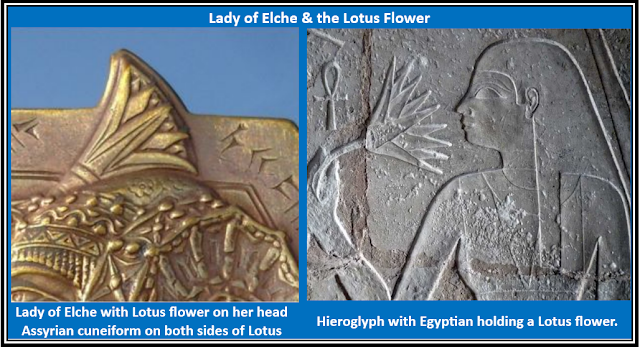The Lady of Elche bust was discovered in 1897 near Elche, Spain. This bust is now displayed at the National Archaeological Museum of Spain in Madrid. Originally the people of Spain called her Reina Mora or Moorish Queen. Notice that the Lady of Elche has Caucasian facial features. Wikipedia states this artifact dates back to the 4th century BC.
Then later the Lady of Elche was found on a medallion (on
buckle) in 1965 in Richfield, Utah. This
artifact was found in an undisturbed area of ground while digging a septic
system, it was found at an unconfirmed depth of about 6 feet. Since then,
others have been found in France.
Notice that both of the Lady of Elches have the same headdress
and necklaces on.
The Mystery History channel did a short video about these
discoveries.
Lady of Elche of Spain
According to the site tuscoro.com,
the Lady of Elche was probably made in Northern Arizona. Below is a quote from this page:
“The Lady bust is said to be of
a polychrome, the art of polychrome apparently has been around for a very long
time. Where it originated seems to be unknown however just for notation keep in
mind that polychrome pots are being found all over Arizona, I guess it is of no
surprise that other cultures would have the same practices who were so far
apart.”
In 1987 another lady’s bust was found in Spain wearing a similar
headdress and necklace.
Lady of Elche of Utah
The Lady of Elche medallion reflects Assyrian (cuneiform)
writing on the top left and top right of the medallion. Below is quoted about this writing from the tuscoro.com
site:
“It is said by an unconfirmed
source that the cuneiform translates as (Left) Tomzartth (Right) Mazzaroth.
According to the scholars, Mazzaroth, a term used by Job 38:32 and is supposed
to mean the Zodiac, Zodiac signs, or ALL of the constellations and after
reviewing the text of the original Hebrew and the King James Bible, others now
are saying it translates to "the Assyrian" I find once again the
supposed learned, does not know. Although possible, I highly doubt it.”
The Lady of Elche medallion reflects a lotus flower on her
head. The Lotus flower is very popular
in ancient Egyptian art work and was associated with
their creation story.
Spain and the American Southwest
Spain and the Southwest of America also had in common the maze
hieroglyphs and they built the same types of villages. See these pages for more information.
1903 New Article; COLUMBUS
DISCOVERED AMERICA FOR SPAIN AND TREASURES
Below from http://chroniclingamerica.loc.gov/lccn/45043535/1903-10-01/ed-1/seq-2.pdf
The Franciscans were in control of
the Holy Places and took American artifacts to Spain. More information can be
found here about this.
https://ephraimamerica.blogspot.com/2018/05/franciscan-control-of-holy-places.html
The Ancestral Pueblo culture of America and the Castro
Celtic culture of Spain and Ireland built the same types of masonry fortified
villages as shown below. For more information, see this page: https://ephraimamerica.blogspot.com/2018/04/ancestral-pueblo-and-castro-celtic.html
The same maze hieroglyph is found in the America southwest, England, Ireland, Spain, Italy, India and Mexico. See video below and this article for more information. https://ephraimamerica.blogspot.com/2018/04/celtic-maze-hieroglyphs-of-arizona.html
Below are different articles with differing opinions
regarding the Lady of Elche. People of
Spain and Southwest America did travel back and forth and had very similar
cultures; therefore, it is possible to find a Lady of Elche in Utah and in
Spain. Hopefully the truth about the Lady of Elche will be agreed on one day.
http://www.tuscoro.com/2018/04/the-lady-of-elche-and-brass-medallion.html
https://en.wikipedia.org/wiki/Lady_of_Elche
https://www.ancient-origins.net/human-origins-religions/indian-goddess-0013406
https://www.reddit.com/r/Cowofgold_Essays/comments/t2h6tt/lotus_in_ancient_egypt/?rdt=58264




